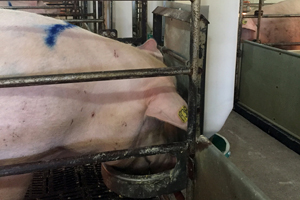Four ways of providing feed in farrowing

Several methods are available to choose from to get sows eating during lactation. Fundamental choices of how to use the labour force as well as investments decide which system a sow farm can use.
Creating the right environment in the farrowing barn can help minimise the challenges producers face when it comes to farrowing healthy piglets. Producers can send more piglets to the nursery or wean-to-finish barn by controlling key elements of the farrowing house environment. Uniform ventilation and strategic heat placement bring success, especially for piglets. However, sow well-being is a constantly growing concern, and sow feeding is an opportunity for improvement.
The main goal for feeding sows is to provide enough nutrients to maximise milk production for her growing litter, yet retain proper body weight throughout lactation. If sows must be fed additionally in the breed row to get her to a better body condition to re-breed, money is wasted. There are four main methods for feeding sows in farrowing.
1. Hand feeding
Hand-feeding is labour-intensive and time consuming, which adds much to the cost of production. Hand scooping from a feed cart into a trough or bowl is the predominant method. As the feed cart passes the stalls, sows usually get up and management can check the health of the animals. Hand feeding is hard to accomplish because it has to occur one to four times a day, generally, and 5-11 kg of mash feed is usually given.
2. Automatic drop feeding
Automatic drop feeding can keep more feed in front of sows for longer periods of time. Labour is less because feed is dropped in intervals throughout the day, and sows’ natural eating habits can be more efficiently matched. Feed is always present, but the challenge is for feed to be palatable. A sow bowl cannot store feed efficiently, as it gets stale quicker than if feed were in a hopper or tube. Another obstacle is that if feed volume or weight is to be measured, the producer must install an apparatus to monitor feed volume or weight for each farrowing stall.
3. Electronic feeding
A newer method of feeding sows is with electronic feeders. Although these are more common for university research or select herds, these systems will monitor the volume and/or weight of feed being delivered to the sow. Individual daily feed consumption is added electronically to a sow’s record via software on a personal computer. The price of a system of electronic feeders in farrowing is usually relatively expensive.
4. Ad lib feeding
Ad lib feeding is a cost-effective method to keep sows in appropriate body condition throughout lactation. Essentially, ad lib feeding is a method which allows sows to eat as much as they like when they are hungry, and is delivered with an engineered feeder. Many configurations of ad lib feeders are available for either dry or wet/dry feeding. Labour isn’t used for feeding, rather for getting sows up and monitoring the litter of piglets. The sow bowl or trough will have a sow-activated mechanism to dispense feed. Consumption can be monitored by recording starting and ending feed volumes, usually over a 24-hour period. Last but not least: Getting sows up allows workers to observe the animals and ensure they are eating and drinking.











